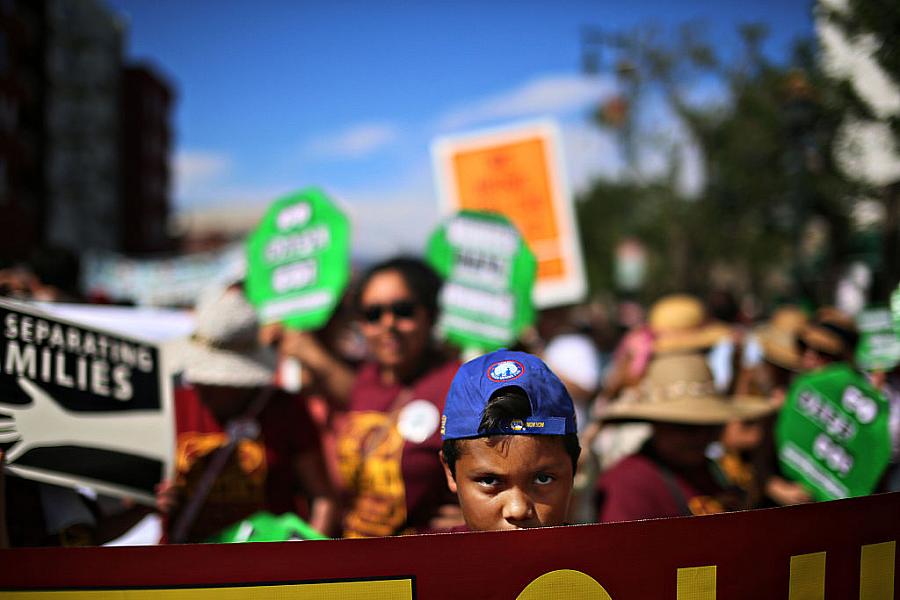The pandemic opened the doors to a more equitable future. Did we let it slam shut?

(Photo by Sandy Huffaker/Getty Images)
For sociologist Manuel Pastor, the coronavirus pandemic and the social unrest that followed George Floyd’s murder were powerful ruptures that promised to clear the way for a more equitable, less racist Los Angeles of the future.
Or as the title of a widely cited report Pastor helped author put it, “No Going Back.”
“The main point of that is that there was no going back, that we shouldn’t go back to a normal that didn’t work for so many people,” Pastor told reporters attending the 2022 California Fellowship via Zoom this week. “In fact, what happened was that COVID was the disease that revealed our weaknesses as a society.”
Pastor, a professor and director of the USC Equity Research Institute, didn’t lack for examples. He pointed to the digital divide, with Black and Latino children far more likely to lack computers and high-speed internet at home (nearly 40% lack them, compared with 13% of white kids). He pointed to the overrepresentation of people of color in high-exposure essential jobs — truck drivers and grocery store workers — and high-exposure nonessential jobs, like retail and hospitality. He pointed to the first federal CARES package, which denied stimulus payments to mixed-status immigrant households.
“That was a deep revelation about who we were and structural inequalities in our economy, in our society and educational system,” Pastor told the Fellows.
These inequities existed long before COVID arrived. But even in the midst of the pandemic and the national spotlight on racism that shortly followed, self-proclaimed progressive states such as California continued to compound these gaps, Pastor argued.
He cited California’s initial website for signing up vaccines, which required digital savvy, flexible work hours and plenty of free time to navigate amid overwhelming demand.
“If there was anything that was an example of structural racism without thinking you’re being racist, it was the way we set up our initial vaccine distribution in the state of California and around the nation,” he said.
Nor is Pastor particularly optimistic about the present and the future. “Today we are in very difficult circumstances because I think a lot of what we learned is being forgotten,” he said.
The state’s growing economic inequality worries him. While California escaped the massive fiscal shortfall many feared COVID would bring about, that’s largely because the state’s progressive tax structure has an outsized reliance on high earners, who could work remotely and watch their investments grow throughout the pandemic. “Rich people have cleaned up in the state,” he said.
Gaps in household wealth are even more striking among households with children under 5. The median income for white households in Los Angeles County is $115,000, compared with about $50,000 for Black and Latino households and $90,000 for Asian American households, according to Pastor.
“The threat is that we’re seriously baking inequality to the future,” he said.
His optimism for the future is further tempered by the degree of polarization in politics at the national level, particularly on issues such as affirmative action and abortion, which he said will constrain what California can do at the state level.
If he’s hopeful about anything these days, it’s his growing belief that we better understand how social movements can bring about new futures. His faith lies in a three-dimensional theory of change: “We need to think about change in terms of mustering data, in terms of changing the narrative, in terms of building community power.”
The example he shared is California’s rising minimum wage, which increased to $15 an hour this year. First, the data: David Card won the Nobel prize in economics last year for research published nearly 20 years ago that showed increases in the minimum wage didn’t hurt employment, as many had long argued it would. Then changing the narrative: The issue gained little traction in the intervening years until labor advocates started framing the issue as a campaign for a “living wage,” Pastor said. “Being in favor of a dying wage is not a good position,” he added. Finally, the force: The Fight for 15 worker movement applied political pressure and started to change the balance of power on the issue.
For Pastor, it’s this kind of behind-the-scenes work of building community power and coalitions to bring about more equitable policies that holds a wealth of underreported stories for journalists.
“The real story of what makes all that possible is this community organizing that almost never gets featured,” he said. “The daily work, the one-on-ones, the development of consciousness. To me, that’s the hidden story to bring forward.”

